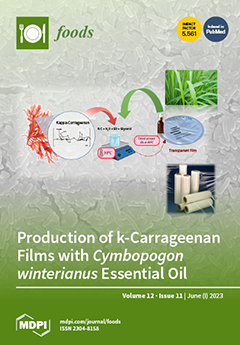Salted eggs are normally produced by treating fresh duck eggs with a high salt concentration in order to acquire distinctive features and excellent preservation capabilities as a result of a series of physicochemical changes. This method, however, induces a high salt content in
[...] Read more.
Salted eggs are normally produced by treating fresh duck eggs with a high salt concentration in order to acquire distinctive features and excellent preservation capabilities as a result of a series of physicochemical changes. This method, however, induces a high salt content in the product. The goal of this research was to create a new way of producing mildly salted duck eggs using ozonized brine salting. The brine was made by dissolving NaCl (26%
w/
v) in water or ozonized water at a concentration of 50 ng ozone/mL (ozonized brine). Compared to brine, ozonized brine resulted in salted eggs with reduced ultimate salt levels in both albumen and yolk (
p < 0.05). The Haugh unit of the salted eggs generated by ozonized brine was similar to that of the brine-made salted egg group (
p > 0.05), but the salted egg produced by ozonized brine matured and solidified faster because the yolk index (0.62) was higher than that of the brine (0.55) (
p < 0.05). The final pH of salted eggs generated with brine and ozonized brine was not different (
p > 0.05). Regardless of the salting method, both salted eggs contained low TVB-N content (<10 mg/100 g). Ozonized brine increased the protein carbonyl content in salted albumen, which may be related to albumen protein aggregation and served as a salt diffusion barrier. However, after boiling the salted egg, the protein carbonyl level was comparable to that of fresh albumen. The TBARS levels of boiled salted albumen prepared with brine and ozonized brine were comparable (
p > 0.05), and the value was extremely low (~0.1 mg MDA equivalent/kg). The TBARS value of the salted yolk prepared with brine was higher than that of the salted yolk prepared with ozonized brine (
p < 0.05), and both salted yolks showed increased TBARS values after cooking (
p < 0.05). The albumen and yolk components appeared to be altered similarly by both brine and ozonized brine, according to the FTIR spectra. Furthermore, the appearance and color of the yolk and albumen in salted eggs prepared with brine and ozonized brine were comparable. Boiled salted albumen produced with ozonized brine had a denser structure with fewer voids. This could be attributed to the final salted egg’s lower salt content and lower salt diffusion rate, which were likely caused by protein oxidation and, as a result, aggregation when ozonized brine was used.
Full article






